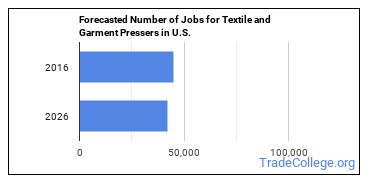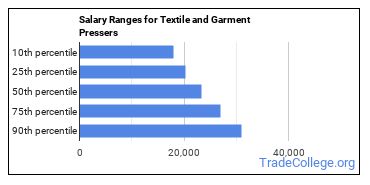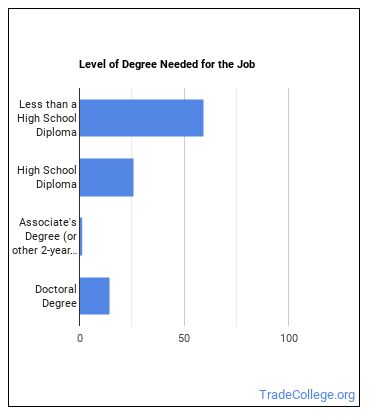Find Trade Colleges
Life As a Textile or Garment Presser
Job Description: Press or shape articles by hand or machine.
Life As a Textile or Garment Presser: What Do They Do?
- Lower irons, rams, or pressing heads of machines into position over material to be pressed.
- Push and pull irons over surfaces of articles to smooth or shape them.
- Spray water over fabric to soften fibers when not using steam irons.
- Measure fabric to specifications, cut uneven edges with shears, fold material, and press it with an iron to form a heading.
- Insert heated metal forms into ties and touch up rough places with hand irons.
- Block or shape knitted garments after cleaning.
Featured schools near , edit
Textile or Garment Presser Required Skills
Textile and Garment Pressers state the following job skills are important in their day-to-day work.
Operation and Control: Controlling operations of equipment or systems.
Critical Thinking: Using logic and reasoning to identify the strengths and weaknesses of alternative solutions, conclusions or approaches to problems.
Operation Monitoring: Watching gauges, dials, or other indicators to make sure a machine is working properly.
Time Management: Managing one’s own time and the time of others.
Types of Textile or Garment Presser
- Manufacturing Associate
- Coat Presser
- Pressing Machine Operator
- Shirt Line Operator
- Hand Presser
Is There Job Demand for Textile and Garment Pressers?
In the United States, there were 45,000 jobs for Textile or Garment Presser in 2016. There is little to no growth in job opportunities for Textile or Garment Presser. Due to new job openings and attrition, there will be an average of 5,200 job openings in this field each year.

The states with the most job growth for Textile or Garment Presser are Montana, Utah, and Nevada. Watch out if you plan on working in Wyoming, Missouri, or Kansas. These states have the worst job growth for this type of profession.
Textile or Garment Presser Salary
The average yearly salary of a Textile or Garment Presser ranges between $18,000 and $31,100.

Textile and Garment Pressers who work in Massachusetts, Alaska, or Rhode Island, make the highest salaries.
How much do Textile and Garment Pressers make in different U.S. states?
| State | Annual Mean Salary |
|---|---|
| Alabama | $20,720 |
| Alaska | $29,390 |
| Arizona | $23,540 |
| Arkansas | $22,880 |
| California | $26,530 |
| Colorado | $24,800 |
| Connecticut | $27,210 |
| District of Columbia | $26,450 |
| Florida | $22,660 |
| Georgia | $20,040 |
| Hawaii | $24,940 |
| Idaho | $23,130 |
| Illinois | $22,530 |
| Indiana | $24,600 |
| Iowa | $23,910 |
| Kansas | $23,670 |
| Kentucky | $24,090 |
| Louisiana | $24,230 |
| Maine | $25,720 |
| Maryland | $26,910 |
| Massachusetts | $33,630 |
| Michigan | $22,990 |
| Minnesota | $28,190 |
| Mississippi | $21,660 |
| Missouri | $22,780 |
| Montana | $25,340 |
| Nebraska | $24,330 |
| Nevada | $23,270 |
| New Hampshire | $24,790 |
| New Jersey | $24,770 |
| New Mexico | $22,110 |
| New York | $27,660 |
| North Carolina | $21,810 |
| Ohio | $23,890 |
| Oklahoma | $19,590 |
| Oregon | $26,020 |
| Pennsylvania | $23,060 |
| Rhode Island | $29,200 |
| South Carolina | $22,300 |
| Tennessee | $26,330 |
| Texas | $21,270 |
| Utah | $23,600 |
| Virginia | $21,560 |
| Washington | $30,330 |
| West Virginia | $25,620 |
| Wisconsin | $25,250 |
| Wyoming | $20,700 |
What Tools do Textile and Garment Pressers Use?
Below is a list of the types of tools and technologies that Textile and Garment Pressers may use on a daily basis:
- Microsoft Excel
- Microsoft Word
- Email software
How do I Become a Textile or Garment Presser?
Education needed to be a Textile or Garment Presser:

How Long Does it Take to Become a Textile or Garment Presser?

Similar Careers
Are you already one of the many Textile or Garment Presser in the United States? If you’re thinking about changing careers, these fields are worth exploring:
- Graders and Sorters, Agricultural Products
- Maids and Housekeeping Cleaners
- Slaughterers and Meat Packers
References:
More about our data sources and methodologies.
